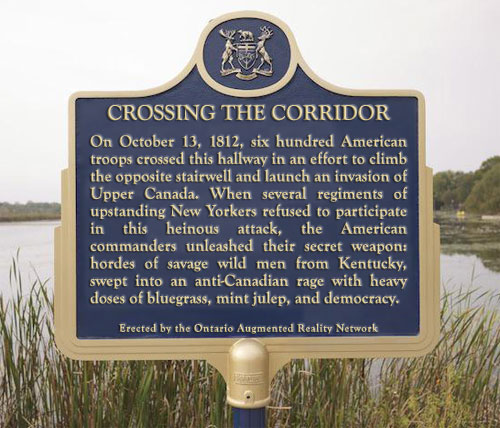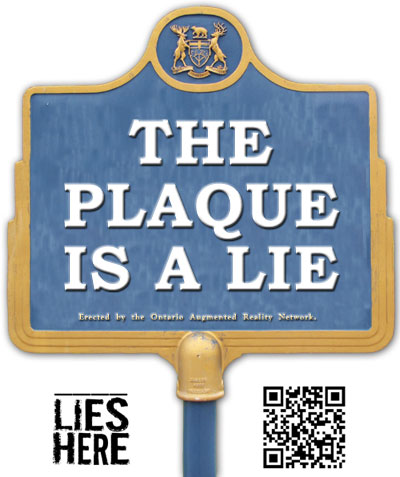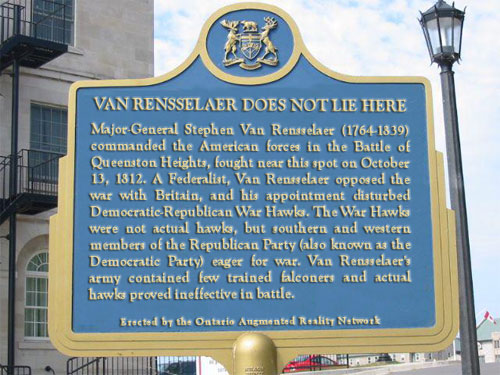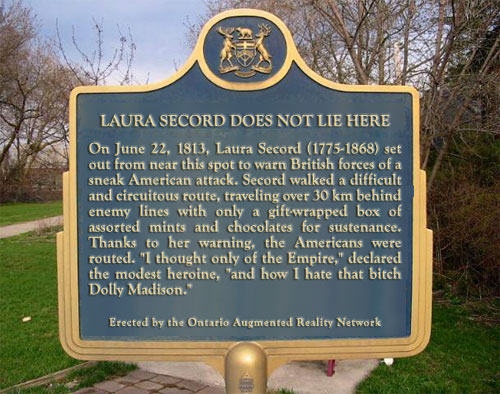Last week I ran a historical ARG created for a conference called Interacting With Immersive Worlds. The conference was, among other things, a coming out party for the Ontario Augmented Reality Network, which is the new home (and funder) of the history games research I’ve been describing in this highly desultory series of posts. (You may recall Chapter 1 or Chapter 2.)
My co-conspirators asked me if I could create some sort of history-themed game to introduce OARN and act as a teaser or prequel for the War of 1812 game we’ve been writing. After a day and a half of panel sessions, we figured people would be ready for some praxis. My original idea was some kind of “barely game”—the quick, low-tech exercises in playful historical thinking I have touted in the past. But it turned out this was to be a plenary session, and I didn’t think Liar’s Club or Paranoid Style would work with 100 people. (A game that does work astonishingly well for 100 people is Jared Sorenson’s Parsely, the text adventure game that subsitutes a human being for the computer parser. If I’d figured out how to spin it as both “historical” and “augmented reality,” I would have played Parsely in a heartbeat and saved myself a lot of work writing silly historical plaques.)
I started thinking about history and augmented reality, and the gripe you hear from time to time (at least you do if you’re talking to me) that 90% of the augmented reality apps we’ve seen to date are just glorified historical plaques. I suspect most historians have a love-hate relationship with the lowly historical marker. The most prosaic form of public history, a historical marker or plaque is written not to offend. It must be vetted by multiple levels of bureaucracy that strip out anything disagreeable, controversial, or profound, leaving behind a bland, authorless authority that only grows blander and more authorless over time.
But people read historical markers. Even Canadian ones! There is something mysteriously compelling about knowing that a historical fact happened right where you stand. George Washington Slept Here. Here Lies Oscar Wilde. This Is The Place. A fact that you wouldn’t bother to look up on Wikipedia becomes fascinating when it meets you in the real world, in a real location. And a place that you might not have given a second thought to is suddenly connected to the great river of history.

The conference took place at Brock University, in St. Catharine’s, Ontario. Brock is named for Major General Isaac Brock, who commanded British forces in Upper Canada during the War of 1812. He was killed at the Battle of Queenston Heights, not far from Brock campus, 199 years ago.
The game I designed was called “_____ Lies Here.” “Here” referred to our focus on place-based history. “Lies” referred to the liberties we took with actual history—but also to the lie of unimpeachable authority embodied by every historical plaque. And “____ Lies Here” was the riddle players needed to solve: Who lies here? (It wasn’t Brock.)

The game itself was simple. Before the conference began on Monday, we posted paper signs all around the site, in hallways, stairwells, and conference rooms. Each bore the picture of a standard historical plaque, along with a cryptic message (“You are being lied to.” “The plaque is a lie.” etc.), and a QR code. But we didn’t mention the signs or make clear that they were connected to the conference until Tuesday afternoon. I wanted people to be vaguely aware of them in an ambient way, maybe curious, maybe not, the way we sort of notice, sort of don’t notice, the traces of the past around us.
The QR codes, when read by a smartphone or other device, directed readers to a URL which asked for their conference badge number. Entering that number took them to the text of a historical plaque, which offered a snippet of history about the place where it was standing, and, like any such marker, contained a mixture of truth and falsehood.
I wrote up forty plaques, telling the story of the Battle of Queenston Heights, where Isaac Brock met his end and Brock University got its name. But it was an irreverent, twisted, goofy version of the history, the way I only wish historical plaques could read. In writing the plaques, I was shooting for something sort of like John Hodgman’s Areas of My Expertise, with its magnificent secret history of a hobo uprising where the funniest facts are often the true ones mixed in among the lies.
What wasn’t obvious to the conference goers was that there were three versions of each plaque—three versions of history, loosely corresponding to a Canadian, American, and Native point of view. Any given badge number would only reveal one of these three narratives. The only way to get the whole story and all the clues to the riddle was to team up and share knowledge with a number of other players.

I felt a little sheepish presenting such a low-tech, simple game to people who study and even make games for a living—especially after the conference program described “Lies Here” as “an Augmented Reality Event showcasing the power and the promise of augmented reality.” One goal of OARN is to bring people from the academic humanities and the computer industry together, and once we do I think we will come up with some really cool stuff. But this particular game was constructed and coded entirely by historians, so the production values were not going to blow anybody away. (Granted, I do know how to use Photoshop. And the historian who did the technical back end was Bill Turkel—no slouch with the code fu.)
But the game was a great success. There were just enough smartphones in the crowd that people had to team up in clusters of two or three, which was ideal. Everybody seemed to get into it, searching hither and yon for the plaques (the crucial 13th marker, tucked away in a women’s washroom, caused considerable consternation) and chortling at the jokes (though I think the Modest Mouse references flew over some heads). It was a terrific icebreaker, fostering conversations among different clots of conference goers. (Maybe every conference should have a plenary game!) Even those who weren’t into it didn’t mind an opportunity to stroll around campus and chat. And the players took just the right amount of time to solve the mystery. The riddle’s answer, as anyone reading this already knows, was Tecumseh, the great Shawnee leader who allied with Brock in the War of 1812. So the game’s solution pointed to “Tecumseh Lies Here,” the more ambitious ARG we are currently constructing. I’ll be posting more about that in due course.
There was one queasy moment, just as I was introducing the game, when Geoffrey Rockwell, one of the top digital humanists in Canada, raised his hand and asked in front of everybody, “What if I know the solution already?” I thought maybe he had pulled some clever Kobayashi Maru-style cheat (just Googling “Rob MacDougall” + “lies here” would have worked), but then I remembered we spent two days talking about the Tecumseh game at another conference last April. Happily, Geoff is much too much a gentleman to have spoiled the game. Instead, he just posted the answer to his blog while everyone else was getting up to play.

It’s still a little funny to have so many historians involved in something called the Ontario Augmented Reality Network. But the partnership makes more sense than it may at first appear. History and augmented reality are natural allies. The past augments the present. Its traces are all around us, but only if we are equipped to see them. Knowing the history of a specific place adds a layer of meaning or significance to our everyday environment. History education can enrich our day-to-day lives, our communities, or our citizenship in part by connecting us to these layers of otherwise hidden or forgotten information. And historical play can offer context, meaning, and incentive for exploring those worlds.
(Many thanks to Kevin Kee for (repeatedly!) trusting me to do something like this, to Bill Turkel for doing all the tech work, and to Tim Compeau, Devon Elliott, Spencer Roberts, and Karen Flindall for indispensable help bringing it all together on short notice.)

Fascinating stuff! Now I’m going to have Stan Rogers’ “MacDonnell on the Hights” going through my head all night.
Thanks, Jonathan. (Random fact: I went to school with Stan Rogers’ kids – his daughter and my older sister were good friends.)
If it’s not too much to ask – and assuming you still check the old posts / still have the files – could you post the plaques or text thereof? It looks like a lot of fun.